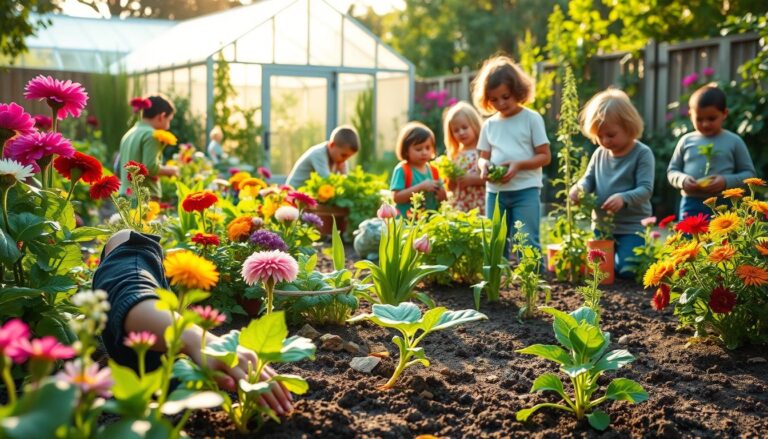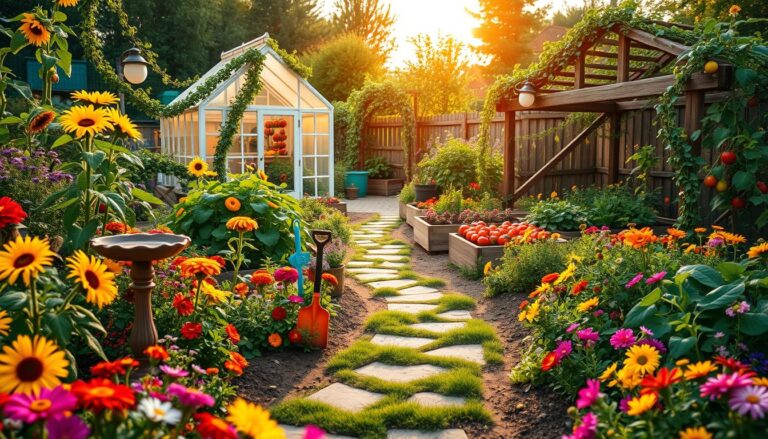Gardening fans are always searching for organic gardening ways to help plants grow better and fight pests. Companion planting is a great method. It means growing different plants together to make them healthier.
This old practice helps create a balanced garden and boosts crop yields. By picking the right companion plants, gardeners can make a space where plants thrive. It’s useful for both new and experienced gardeners.
Exploring companion planting can turn your garden into a lush paradise. It’s a simple yet powerful way to make your garden flourish.
What Is Companion Planting?
Gardeners can make their gardens better by choosing the right plants to grow together. This is called companion planting. It means placing different plants near each other to help them grow better, taste better, and fight off pests.
Definition and Core Concepts
Companion planting is a way to make gardens stronger and more diverse. It’s based on the idea that some plants help others grow better. For instance, some plants keep pests away from others, while others attract good bugs or make the soil better.
To make companion planting work, you need to know how different plants interact. Some plants might compete for things like light or water. But others can provide shade, support for climbing plants, or even improve the soil for their neighbors.
Historical Background and Evolution
The idea of companion planting comes from old gardening and farming ways. Many ancient cultures knew how to grow plants together for their benefits. Now, with science, gardeners can choose the best plant combinations for their gardens.
Today, companion planting is key in organic gardening and green farming. It helps gardens be more diverse and cuts down on the use of harmful chemicals.
Benefits of Companion Planting
Companion planting is a smart way to make your garden peaceful. It pairs plants that grow well together and fight pests. This makes your garden healthy and beautiful.
Improved Plant Growth and Yield
Companion planting boosts plant growth and yield. For example, marigolds help tomatoes grow by fighting nematodes. These pairings make your garden more fruitful.
Natural Pest Management
It also helps manage pests naturally. Plants like basil and mint keep pests away. This means no harmful chemicals and safer food. It keeps your garden healthy and green.
Efficient Use of Garden Space
It’s also great for using space wisely. Plants with different heights fit together well. Like sunflowers and lettuce, they save space and look good together.
Some good pairs to try are:
- Tomatoes and basil
- Cucumbers and dill
- Marigolds and carrots
Using these tips, you can make a garden that’s full of life and beauty. It’s all about garden harmony.
The Science Behind Plant Relationships
Plants in a garden have complex relationships. They interact through chemicals, physical contact, and their environment. Knowing how these interactions work is crucial for using companion planting effectively.
Chemical Interactions Between Plants
Plants talk to each other through chemical signals. These signals can help or hurt growth. This is called allelopathy.
Allelopathy: Friend or Foe?
Allelopathy can be good when plants send out chemicals that keep pests away or attract helpful bugs. But, some plants release chemicals that slow down their neighbors. For example, Juglans nigra (black walnut) has a chemical called juglone that can stop some plants from growing. Knowing about allelopathy helps gardeners pick the right plant combinations.
Physical and Environmental Factors
Physical and environmental factors like light, temperature, and soil quality are also important. Some plants offer shade, which cools the soil and keeps it moist. Others might fight for the same resources. For example, planting nitrogen-fixing legumes with other veggies can improve soil health by making more nutrients available.
Essential Companion Planting Guide for Beginners
Companion planting is a simple yet effective way to boost your garden’s health and productivity. By choosing the right plants to grow together, you can create a balanced and thriving garden ecosystem.
To get started, it’s essential to understand the basics of companion planting. This involves selecting plants that complement each other in terms of growth habits, pest resistance, and nutrient uptake.
Getting Started with Basic Combinations
Begin with simple and well-known combinations like the “Three Sisters” method. This involves planting corn, beans, and squash together. The corn provides a structure for the beans to climb, while the squash shades the soil, preventing weeds and retaining moisture.
Other beneficial combinations include planting marigolds with tomatoes to deter nematodes. Also, basil with lettuce improves flavor and reduces pests.
Reading and Creating Plant Compatibility Charts
A plant compatibility chart is a valuable tool for planning your companion planting garden. These charts help you identify which plants can be grown together successfully and which should be kept apart.
To create your own chart, start by listing the plants you want to grow. Then, research their compatibility. Use online resources or gardening books to gather this information. Organize your findings into a table or chart, making it easier to visualize and plan your garden layout.
By following this companion planting guide, you’ll be well on your way to creating a harmonious and productive garden. This garden will benefit from the natural synergies between different plants.
Popular Plant Combinations That Work
Gardening fans know that some plants help each other grow better. This is called companion planting. It makes gardens more diverse, strong, and fruitful. By picking the right plants together, gardeners can make the soil better, fight pests and diseases, and even taste their food better.
Vegetable Companions
Pairing different vegetables is a smart move. For example, marigolds with tomatoes keep nematodes away. Basil makes tomatoes taste better.
The Three Sisters Method
The Three Sisters method is a great example. It grows corn, beans, and squash together. Corn helps beans climb, beans fix nitrogen, and squash keeps the soil cool and moist.
Herb Companions
Herbs are great friends to vegetables. They help fight pests and make food taste better. Chives near carrots keep aphids away, and rosemary keeps carrot flies off.
Flower Companions for Vegetables
Flowers are important too. Nasturtiums keep aphids and whiteflies away from veggies like cabbage and kale. Sunflowers shade cool plants and help climbing veggies.
| Plant Combination | Benefits |
|---|---|
| Tomatoes and Basil | Improved flavor, repels pests |
| Corn, Beans, and Squash (Three Sisters) | Mutual support, improved soil health |
| Marigolds and Tomatoes | Repels nematodes |
| Nasturtiums and Cabbage/Kale | Repels aphids, whiteflies |
Plants That Don’t Get Along: What to Avoid
Knowing which plants don’t get along is key for garden harmony. Companion planting aims to create good relationships between plants. But, it’s also vital to know which plants should stay apart. Some plants release chemicals that harm others, while others compete for water, nutrients, or light.
Common Antagonistic Relationships
Some plants don’t get along. For example, broccoli and cabbage from the Brassicaceae family shouldn’t be near tomatoes and potatoes from the Solanaceae family. This is because they share diseases. Fennel also slows down the growth of many plants, including tomatoes and beans, and should be planted alone.
Onions and beans don’t mix well either. Onions can stunt bean growth, and beans don’t do well near gladiolus. Knowing these facts helps gardeners plan better.
Why Some Plants Compete or Inhibit Growth
Plants compete or inhibit each other for many reasons. They might fight over resources, release chemicals that harm others, or block sunlight. Sunflowers, for example, can shade out smaller plants. Black walnut trees release a chemical called juglone, which is toxic to many plants.
By understanding these conflicts, gardeners can choose the right plants to grow together. This leads to a more balanced and healthy garden. It also helps with natural pest control and overall garden health.
Intercropping Tips for Garden Harmony
Intercropping means growing many plants together in one spot. It’s a smart way to make your garden balanced and full of life. By picking the right plants and arranging them well, you can create a garden that thrives.
Spacing Considerations
Spacing is key in intercropping. Adequate spacing lets each plant get what it needs without fighting for it. For example, marigolds and tomatoes can grow together. But make sure marigolds don’t block the tomatoes’ sunlight.
Timing Your Plantings
When you plant is important too. Synchronizing the growth cycles of plants helps them work together better. Radishes and carrots, for instance, can grow well together. Radishes help carrots grow by loosening the soil.
Maximizing Yields in Small Spaces
In small gardens, getting the most out of your space is crucial. Vertical gardening and companion planting can really help. The “Three Sisters” method, with corn, squash, and beans, uses space well and helps plants grow better together.
Gardening expert says, “Companion planting is more than just pairing plants. It’s about building a diverse garden that grows well and fights off pests and diseases.”
“The right companions can make all the difference in your garden’s health and productivity.”
Planning Your Companion Planting Garden
To get the most out of companion planting, you need to plan carefully. This means understanding how different plants work together. You want to boost growth, fight pests, and improve soil health.
Mapping Your Garden Layout
Creating a garden layout for companion planting takes some thought. You must think about the size of plants and their needs. Also, consider how they interact with each other.
Begin by drawing your garden beds and picking which plants will go together. A companion planting guide or plant compatibility chart can really help at this point.
Sample Garden Plans
Here’s a simple example of a companion planting plan:
| Plant | Companion Plants | Benefits |
|---|---|---|
| Tomatoes | Basil, Marigold | Improved flavor, repels nematodes |
| Cucumbers | Dill, Radish | Repels aphids, improves growth |
Seasonal Rotation Strategies
Rotating your crops seasonally is key to keeping soil healthy. It helps avoid pests and diseases. You need to plan which plants will come after others in your garden beds.
For instance, planting legumes after heavy feeders like tomatoes can add nitrogen to the soil. A good rotation plan can make your garden healthier and more productive.
Companion Planting for Natural Pest Control
Companion planting is a smart way to keep pests away from your garden. It uses the natural bonds between plants to fight pests.
This method cuts down on chemical pesticides. It makes your garden healthier and more balanced. By picking the right plants, you can defend your garden naturally.
Repelling Harmful Insects
Some plants can keep pests away from other plants. For example, marigolds keep nematodes, whiteflies, and other pests off with their strong smell.
Garlic and chives also keep aphids and other soft-bodied insects away. Planting these near vulnerable crops can greatly reduce pest problems.
Trap Cropping Techniques
Trap cropping is a smart trick. It involves planting a crop that pests prefer over your main crop. This way, pests go after the trap crop instead of your main plants.
For example, nasturtiums can draw aphids away from more valuable crops. This method protects your main crop and helps control pests in a green way.
Attracting Beneficial Insects
Companion planting also attracts good bugs that eat pests. Dill and fenugreek attract ladybugs and lacewings, among others.
By welcoming these beneficial insects, you boost your garden’s natural defense. This leads to a more balanced and healthy garden ecosystem.
Improving Soil Health Through Companion Planting
Soil health is key to a thriving garden. Companion planting helps a lot. By picking the right plants to grow together, gardeners can make soil better. This leads to healthier plants and more food.
Nitrogen-Fixing Plants
Nitrogen-fixing plants are vital for soil health improvement. Legumes like beans and peas turn atmospheric nitrogen into plant food. This cuts down on the need for chemical fertilizers, supporting organic gardening.
Dynamic Accumulators and Soil Builders
Dynamic accumulators pull nutrients from deep soil, making them available to other plants. Plants like comfrey and dandelion have deep roots. They bring up nutrients, helping other plants grow better. Used as companions, they make the garden healthier and more productive.
Conclusion
Companion planting is a key to garden harmony. It helps plants work together, making your garden healthy and balanced. This way, you don’t need to use harmful chemicals.
A good companion planting guide is essential. It helps you pick the best plants to grow together. This improves soil, keeps pests away, and boosts your harvest. It’s great for both new and experienced gardeners.
Starting with companion planting? Begin small and be patient. Watch how your plants interact and change your plan if needed. With practice, you’ll learn to create a garden that’s full of life and gives you joy.
FAQ
What is companion planting, and how does it work?
What are some examples of beneficial plant combinations?
How can I create a companion planting chart for my garden?
What are some common mistakes to avoid in companion planting?
Can companion planting help with natural pest control?
How can I use companion planting to improve soil health?
What is intercropping, and how does it relate to companion planting?
How can I plan a companion planting garden?

Sortemdia nasceu com o propósito de trazer alegria e oportunidades para todos por meio de sorteios gratuitos de prêmios incríveis. O site tem como missão oferecer experiências acessíveis, divertidas e justas para quem deseja concorrer a produtos, serviços e brindes sem pagar nada por isso. Acreditamos que a sorte pode bater à porta de qualquer pessoa — e no Sortemdia, ela pode chegar com apenas um clique.



